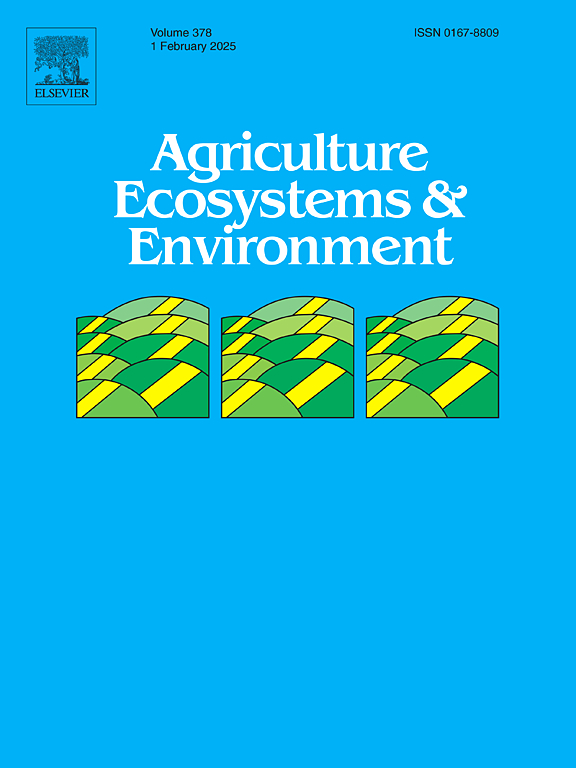Effect of various methods of mineral fertilizer application on changes in the abundance, composition, and diversity of culturable fungi in a reduced tillage crop rotation system of winter wheat, soybean, and maize
IF 6
1区 农林科学
Q1 AGRICULTURE, MULTIDISCIPLINARY
引用次数: 0
Abstract
Modifications to the tillage system and methods of fertilizer application demand investigation and assessment of their impact on microbial communities in cultivated soils. This study used cultivation-based methods to analyze the abundance, composition, similarity, and species diversity of culturable fungal communities in the rhizosphere and non-rhizosphere soil under a reduced tillage, rotational wheat-soybean-maize cultivation system. The trial involved application of subsurface mineral fertilization (NPKS), with surface fertilization serving as a reference point. Subsurface application of mineral fertilizers increases the efficiency of nutrient uptake and promotes better plant growth, and reduces fertilizer losses due to leaching and volatilization. It was demonstrated that among the 4 experimental factors tested (plant species, fertilization variant, ecological niche, and years of study), the crop had the greatest significant differential effect on the mycological indices under study. Significantly higher (α=0.05) total counts of culturable fungi in the rhizosphere and soil were recorded under cereal cultivation, i.e., maize and wheat, while the lowest counts were observed in soybean cultivation. Under maize cultivation, the composition and frequency of dominant genera of these fungi significantly differed from those under wheat cultivation, and to a lesser extent under soybean cultivation. In maize cultivation, significant differences were also observed between the rhizosphere and soil in population density distribution of certain species. The similarity in species composition decreased, while species diversity increased as a result of deep application of NPKS fertilizer in maize and soybean cultivation, as well as after surface application in wheat cultivation. Subsurface fertilization significantly increased the overall abundance of rhizospheric fungi, especially in maize. This was particularly evident in 2015 and 2016. In 2015, the abundance of rhizosphere fungi in subsurface-fertilized plots was nearly twice as high (higher NPKS dose) to 2.5 times higher (lower NPKS dose) compared to surface-fertilized treatments. The abundance of these fungi in the non-rhizosphere soil under maize cultivation was twice as high compared to subsurface fertilization. The method and dosage of fertilizer application did not cause significant differences in the population structure of dominant genera and species. Significant differences in the overall abundance of culturable fungi and the frequency of dominant genera and species populations were observed during the study years. The article discusses the reasons for differences in the overall abundance, composition, and frequency of dominant genera and species of culturable fungi, depending on the experimental factors investigated. Additionally, the taxonomic (composition) and spatial (frequency) structure of these fungi is comprehensively described.
不同矿肥施用方式对冬小麦、大豆和玉米免耕轮作系统中可培养真菌丰度、组成和多样性变化的影响
耕作制度和施肥方法的改变对栽培土壤微生物群落的影响。本研究采用以栽培为基础的方法,分析了免耕小麦-大豆-玉米轮作系统下根际和非根际土壤中可培养真菌群落的丰度、组成、相似性和物种多样性。试验采用地下矿物施肥(NPKS),以地表施肥为参照点。地下施用矿质肥料提高了养分吸收效率,促进了植物更好的生长,并减少了因淋失和挥发而造成的肥料损失。结果表明,在4个试验因子(植物种类、施肥方式、生态位和研究年限)中,作物对真菌学指标的差异影响最大。玉米和小麦的根际和土壤中可培养真菌总数显著高于玉米和小麦(α=0.05),大豆的根际和土壤中可培养真菌总数最低。玉米栽培条件下,这些真菌的优势属组成和频率与小麦栽培条件下差异显著,大豆栽培条件下差异较小。在玉米栽培中,某些物种的种群密度分布在根际和土壤之间也存在显著差异。玉米和大豆深施NPKS肥以及小麦地表施NPKS肥后,物种组成相似性降低,物种多样性增加。地下施肥显著增加了根际真菌的总体丰度,尤其是玉米。这在2015年和2016年尤为明显。2015年,与地表施肥处理相比,地下施肥处理的根际真菌丰度几乎是地表施肥处理的两倍(NPKS剂量较高)至2.5倍(NPKS剂量较低)。在玉米栽培下,这些真菌在非根际土壤中的丰度是地下施肥的两倍。施肥方式和用量对优势属和优势种的种群结构无显著影响。在研究期间,观察到可培养真菌的总体丰度和优势属和种群体的频率存在显著差异。本文讨论了可培养真菌的优势属和种的总体丰度、组成和频率差异的原因,这取决于所研究的实验因素。此外,还对这些真菌的分类(组成)和空间(频率)结构进行了全面的描述。
本文章由计算机程序翻译,如有差异,请以英文原文为准。
求助全文
约1分钟内获得全文
求助全文
来源期刊

Agriculture, Ecosystems & Environment
环境科学-环境科学
CiteScore
11.70
自引率
9.10%
发文量
392
审稿时长
26 days
期刊介绍:
Agriculture, Ecosystems and Environment publishes scientific articles dealing with the interface between agroecosystems and the natural environment, specifically how agriculture influences the environment and how changes in that environment impact agroecosystems. Preference is given to papers from experimental and observational research at the field, system or landscape level, from studies that enhance our understanding of processes using data-based biophysical modelling, and papers that bridge scientific disciplines and integrate knowledge. All papers should be placed in an international or wide comparative context.
 求助内容:
求助内容: 应助结果提醒方式:
应助结果提醒方式:


